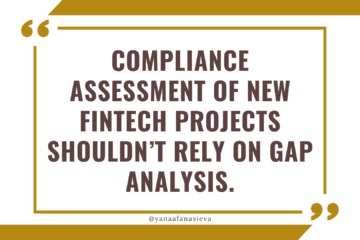Why Very Few FinTech Startups Keep Growing… While Most Others Run Out of Money?
Why is it that very few FinTech startups keep growing, secure licenses and partnerships they want, and are loved and praised by their customers… while most other startups struggle and run out of money? They all operate in the same environment, get almost the same level of seed investments, graduate from the same incubators, are subject to similar regulations, and face the same competition… What is it that those successful few FinTech have figured out?
- If you are a FinTech startup struggling to allocate limited resources between marketing, regulatory consultants, or hiring more engineers…
- If you are unable to focus on growing your business because you constantly produce long explanations for your regulators, auditors, bankers, and other financial partners who continuously threaten to shut you down or cut you off… and don’t know how anyone would ever be able to satisfy them…
- If your compliance is getting more expensive and slower day by day and you simply cannot afford to hire more people to do what needs to be done…
Then read on.
By the time you will finish this summary, you will have clarity about the core success ingredients any growing FinTech needs to massively scale operations in a sustainable way.
Despite how much content and free advice and paid seminars exist on every single compliance topic imaginable, why is that that most startups and founders and their compliance teams continue to struggle and don’t know what to do?
In a decade of working in FinTech compliance, I came to believe that the majority of people don’t realize that all they need to do is to align their decisions about compliance to the same approach they deploy to technology development.
“Just in time” or “agile” approach to compliance is the fastest and most efficient way to scale your FinTech, launch innovative products, and keep customers happy.
Just think about it, the tech component in FinTech is how compliance is delivered: using tools, integrating vendors, developing rules, and monitoring dashboards. Agile “just in time” methodology is a proven most recognized approach to delivering tech products, through testing and iterations. It ensures your next investment of time and resources is based on feedback and data, and you don’t over-invest in projects that don’t work.
This is why the only way for FinTech compliance to fuel business growth and protect the company from risks is to adopt the same pace and the same approach to compliance decision-making, as you apply to sprint planning.
We have seen countless examples of so many FinTech companies that get into compliance troubles when their compliance is ignored and does not catch up with the growth pace. At the same time, we have seen even more examples from the traditional banking side, where compliance becomes too inflexible, heavy, slow, and too risk-averse and hinders growth and innovation.
So many founders ask me a question: “Can you please give me a complete list of all the requirements and everything I need to do to be compliant? I just want to understand the full scope of it”.
- Do you know what they do when they get this full list of requirements?
- You guessed right – they do absolutely nothing with it because they feel overwhelmed, they realize it cannot be done in a reasonable time, and they see why so many formal requirements won’t even make sense for their product.
- Then they try to prioritize what’s possible, pick and choose, negotiate and bargain with their teams and auditors or partners… This is instinctively a step towards an agile approach, but it is usually made in the middle of heated debates, team conflicts, and without impact assessment.
If you have ever felt frustrated and stuck dealing with large organizations or regulators thinking “How do I move things faster, and how do I even understand why it takes so long?”, chances are, you can relate.
When I first started working for Amazon and PayPal, I quickly learned that it’s absolutely possible to run a compliant business at scale, serving millions of customers spending less than a second per customer, and not be afraid of millions of complaints and millions of fraudsters. I learned to see risks and consequences in proportion (statistically and pragmatically), I learned to rely on technology and indirect data to understand and profile customers and monitor what they do, simply because, within large and ever-growing companies, it’s impossible to manually confirm everything.
But the longer you work for a larger company and the more responsibilities you get, the more you see that when it comes to making decisions about new projects, decisions are extremely slow.
It was a big part of my job to review and assess new projects and FinTech initiatives. For example, at PayPal, it was my job to develop compliance criteria for enabling Forex trading, gaming, and gambling verticals as well as to review integration proposals with companies such as M-Pesa, Payoneer, and many other FinTechs.
PayPal definitely had the technology and resources and know-how to enable any of those projects, and it would probably be profitable for all parties involved, but the ultimate decision was very often “no” or “not now”.
Why? Two main reasons.
– Enabling such partnerships would often mean making an exception, deviating from a standard process, or introducing a manual workaround… and these large companies know all too well, that this is not scalable.
– Sharing customers or processes or payment flows with FinTechs involves decision-making about risks, and even though PayPal technology may have been agile, and compliance operations were quite automated and scalable, their decision-making process around risk became very inflexible and rigid.
Now, after 4 years of working with startups and over a dozen successful license applications and partnership approvals and projects completed and gone live, the biggest lesson I learned after moving from Big Tech into the startup world: if you want to keep growing and innovate, as a startup, but at the same time you need approvals from regulators and banks and partners, the only efficient way to get things done and keep moving forward is to plan for surprises and expect uncertainty, and not overspend resources and not hire people before you actually need them, which is exactly what I call agile and lean compliance. This is what I call “just in time” as opposed to “just in case”.
Are you curious to see, where your startup might be on its journey to lean and scalable compliance?
Here is how I see the FinTech Compliance Function Evolution
- Age of Innocence: You assume you are not regulated, too small, unprofitable, and therefore, no rules apply to you. You may be taking some funds from friends and family or experimenting with DeFi or AlgoTrading, and you will worry about compliance later.
- Stone age: Your customer files are stored as google docs, your decisions about customers are done via emails or on Slack, and your transaction monitoring routine is supported by CSV file exports into excel. Expensive external lawyers have written some of your T&Cs or policy documents, but nobody in the company actually read them or knows if it’s relevant. You just hope it’s ok what they wrote and you proudly mention that this policy or document was created by the Big 4 company. Your customer onboarding may be semi-automated, but after the customer uploads the documents and you get the data, all the following manipulations and decisions are manual. You don’t have good internal admin tools or dashboards, you don’t have any customer tags, and when you do sanctions scanning or blockchain tracing, it’s manual and the results are saved as screenshots. Your next audit or regulatory inspection will turn out badly, this is when you will hire more people and deploy more random tools, and will graduate into firefighting mode.
- Firefighting: You have hired a lot more people into risk and compliance, you deploy many tools (that don’t agree with some of the alerts and results they generate), and you constantly talk about your backlog of the issuer. Your compliance cost per customer is getting more expensive day by day. You have wasted lots of resources preparing for projects that never went live and you waste a lot of resources on customers that register but don’t transact. Your customers are complaining a lot about how long they need to wait while you review them. Your company suffers from internal conflicts between compliance, product, engineering, and customer support, and you have a feeling that everything is slow, despite all the resources you put into compliance.
- Leverage: For some products or some services or partnership channels you managed to find the right balance between compliance and growth, which means that each next customer costs you less to onboard and maintain than the previous customer. You have a few compliance tools and vendors and you consolidate information about them within a single dashboard. You don’t need to hire temporary interns to address and resolve your backlog, your audits and regulatory inspections are clean and you actually get positive feedback. Your compliance team is spending the majority of its time reviewing new projects and new opportunities and future ideas instead of focusing on formalities, audits, and reporting. You found the right balance between what you need to develop in-house in terms of technology and documents versus what you outsource to vendors and external lawyers and consultants. Your financials look healthy and you can raise more funds because of that.
At this point in time, you might have recognized some of the painful symptoms and begin to see the benefits of applying agile compliance within your business.
How do you get started?
The easiest way of getting started is to take any area where you typically get stuck and find a new way of achieving your desired outcome with fewer resources, fewer people, and in less time.
Many startups and startup founders are dreading external audit experience, and if you’d like to learn how to prepare for the external FinTech audit, how to reduce the cost of it, and make sure you know what to answer, what’s the right level of details, and how to prepare and provide the data, you are welcome to join my 2-hour Workshop on How to Prepare for Audits during December 8th and 9th next week.
Check out the agenda HERE!
Hope it helps!


